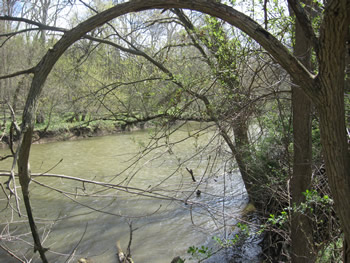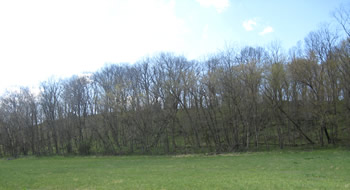Mud of our fathers
13 April 2008
Or: another great day on the battlefield.
I was glad to be part of a small group of SHAF volunteers and Park Natural Resources guys planting tree seedlings along Antietam Creek yesterday.
It was in a part of the Park I’d never visited before: a strip of low land along the west side of the stream running north from where the Burnside Bridge Road crosses about one-quarter mile above Burnside Bridge.

A new forest of green tubes (looking northeast, creek to the right)
A larger team of about 35 people had been nearby planting the weekend before, during the Park Work Day. Between us, then, we’d planted hackberry, tulip poplar, and maple (others?) three and four deep along a half-mile of creek bank. These are all native species likely to do well in that location.
These trees and the grassy field adjacent will form a riparian buffer to protect the stream and its banks. The seedlings themselves are protected and nurtured by those ‘greenhouse’ sleeves and stakes.

view back across Antietam Creek from west bank
On the afternoon of 17 September 1862 this ground was the province of the troops of Colonel Benjamin Christ‘s Brigade (First Brigade, First Division) of the Federal Ninth Corps.
They had crossed the stone bridge to the west bank about 2pm and followed it north to this meadow. About 3pm they formed in line of battle here preparatory to advancing toward the town of Sharpsburg [map]. In order south to north (l to r) , behind the 79th New York Infantry as skirmishers, these were the 17th Michigan, 28th Massachusetts, and Christ’s own 50th Pennsylvania regiments.

bluff west of Antietam Creek, north of bridge road
With their backs to the creek, they faced a stiff climb up that steep slope.
… after the formation of the Corps line, the Brigade advanced, under a heavy fire from Cemetery Hill and the high ground west of the road, to within a few yards of this point where it was checked. After a short delay the 79th New York advanced as skirmishers and compelled the Confederate Artillery to retire. The Brigade was about to move forward, when the attack of A.P. Hill on the left of the Corps obliged it to fall back to the Antietam …
(from War Department tablet no. 63 [map])
____________
Thanks to Tom Clemens and SHAF for sponsoring the planting, the Natural Resource Rangers for doing what they always do: take such fine care of our Park, the Chesapeake Bay Foundation (CBF) for the young trees, and to the other volunteers for getting muddy with me.
____________
For related photos–including one of Christ’s Brigade’s tablet–see a lovely page from Tom Shay created on the 100th anniversary of the raising of the monuments to 48th and 50th Pennsylvania regiments at Antietam in 2004.

April 15th, 2008 at 11:08 am
Brian,
I suspect this planting is simply to form the riparian buffer, as you mentioned in the entry. This may be a stupid question considering I’ve never been to the battlefield, but how close to an 1862 era view is the landscape around Sharpsburg, and are there any plans to create the same historic view as is currently happening at Gettysburg?
Brett
April 15th, 2008 at 9:23 pm
Hi Brett,
Antietam is among the best-preserved battlefields in the country, and is very close in appearance to 1862.
Most of the farm lots in and around the Park have been kept in just about continuous use for their original purposes, and the usual urban sprawl has been kept at a distance. Fences and roads have changed a bit, and some modern structures have popped up, but as the Park has acquired so much of the property, no more can be built directly on the field, and some of those already there have/will be removed.
Even the town of Sharpsburg itself is remarkably similar to the way it was then. It’s a sleepy small town of about the same size today, with large numbers of original structures. Long stretches of the drive to the battlefield from just west of Frederick – the route of the Federal Army along the (Old) National Pike – still looks much like it did in 1862.
The most obvious difference between 1862 and today at Antietam has been in the de-forestation of the North and West Woods since the battle. Correcting this has been a major endeavor of the Park Service and thousands of volunteers for more than 10 years now. [more]
Various other planting and restoration projects over the last few years have helped to push the Park even closer to its appearance at the day of the Battle. More are underway or planned.
Obviously there’s no going all the way back (the monuments and Park roads, for example, are likely to remain), but it’s a gem of a place as it is now.
April 16th, 2008 at 8:59 am
Brian,
Thanks for the detailed and lengthy answer! I had forgotten the fact that the North and West Woods had lost a lot of trees since 1862, but I did not realize just how pristine the Antietam battlefield was. Thanks also for the link to the NPS Antietam site. I’m heading over to take a look now.
Brett
April 18th, 2008 at 7:09 am
Brian, I was down in that section of the battlefield the first weekend of April. Gained new insight into the linkage between V Corps and IX Corps in that sector. My understanding was some of the Regulars actually pushed out their skirmish line to about where the NPS Sherrick Farm trail reaches the creek bottom (near your photo of the tree farm is) in the morning, but pulled those back around mid day.
Craig.
April 19th, 2008 at 8:19 am
Hi Craig,
Thanks for the note – good point about the Fifth Corps. Plenty of fuel for “what-if” speculation on that part of the field, too.
April 21st, 2008 at 12:16 am
Thanks for the publicity, it was great having your help last weekend. I always find these scenic restoration projject to be so personally fulfilling. After a week of desk work and teaching it is nice to get my hands dirty now and then.